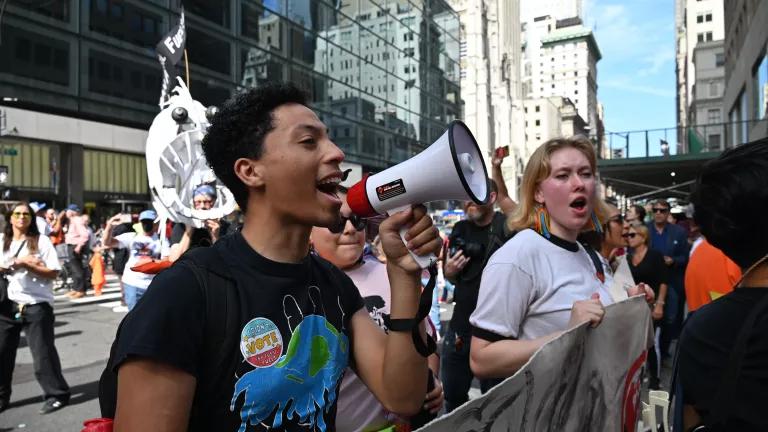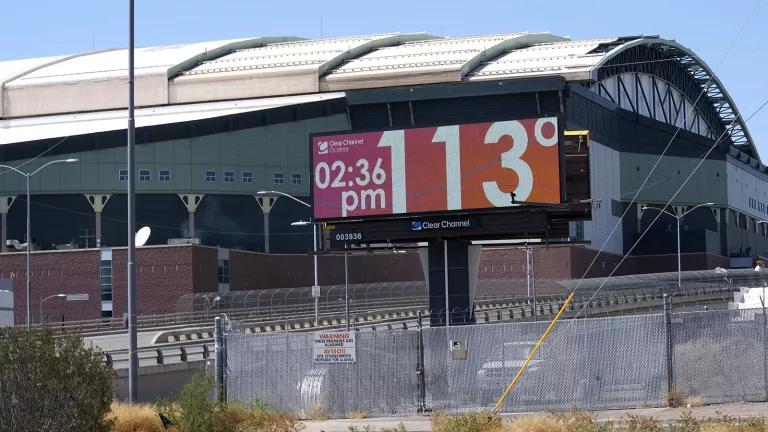New York City's ambitious climate change plan shows we must do more now to stop carbon pollution
In announcing his plans for New York City to battle the inevitable effects of climate change, Mayor Michael Bloomberg has shown leadership where many local and national politicians have not. Although Superstorm Sandy was the spur to create the Special Initiative on Rebuilding and Resiliency, the mayor and his aides have made it clear they are worried about more than monster hurricanes. (As we’ve noted before, a storm like Sandy was, while unprecedented, actually foreseen. We knew previously, as we know now, that the combination of sea level rise and stronger storms could be deadly.)
The threats to the city from climate change are many, from rising sea levels to an increase in killer heat waves to sudden downpours that can flood the subways and tunnels. The city actually laid the groundwork for today’s sweeping plan with the mayor’s PlaNYC, released in 2007, to prepare the city for future developments, including climate change. Among other things, it set a goal of reducing the city’s carbon emissions by 30 percent, with special attention to improving the energy efficiency of buildings.
Now the city has gone a step further, examining in detail the possible scenarios in the medium and long term from climate change. The result is a harrowing picture. By 2050, the number of residents living in the 100-year flood plain zone (defined as those areas of the city where every year there is at least a one percent chance of flooding) could double to 800,000, from the current estimated 400,000 (which itself is a figure representing nearly twice as many vulnerable residents as shown on official FEMA maps that were in use before Sandy.)
Heat waves, which are often the most fatal extreme weather events, will become more common as New York City endures as many 90-degree days in 2050 as Birmingham, Alabama does today. Last month, a scientific paper posited that heat-related deaths in Manhattan alone in the 2020s may rise more than 30 percent over the number of such deaths in the 1980s. And the study debunked claims by climate deniers that fewer deaths during warmer winters will compensate.
The sea level at New York City has risen by a foot since 1900, but that rate is likely to accelerate. Under one scenario, it could rise another 2.5 feet by 2050. That means two things: one, portions of the city’s coast will flood on a regular basis simply due to tidal action. And a storm surge with seas that high could be as much as five to six feet higher than the storm surge from Sandy, which was already 40 percent above the previous record, set in 1960.
The mayor has rightly decided to face the future, instead of passing the problem onto his successors, or putting his head in the sand of climate denial. There are at least two important lessons to draw from New York’s plan of action.
The first is that other cities, states and the federal government should be like Mike and start making plans to adapt their infrastructure, their building codes, their protective structures, their power grids, their emergency procedures and all the rest to deal with impacts of climate change. (They should not do what the state of North Carolina did last year, which was to enact a law that prevents all state and local agencies from developing regulations or planning documents that consider the possibility of a significant rise in sea levels.)
NRDC, for instance, has been urging the Federal Emergency Management Agency to ensure that states factor climate change into their disaster preparedness plans. Too many states rely solely on historical data in determining their level of preparedness for droughts, floods, or storm damages. By ignoring the impacts of climate change on the frequency and severity of these events, states are failing to prepare adequately for future emergencies. Mayor Bloomberg’s announcement is a great opportunity for FEMA to take this long-overdue step. Coastal states could adopt plans similar to those proposed by New York’s governor Andrew Cuomo to buy out residents in especially low-lying, flood-prone areas and restore the land to its natural state.
This kind of planning and adaptation may seem expensive at first, but this is where spending pennies now can save dollars down the road. As a recent NRDC analysis showed, when all federal spending on last year’s droughts, storms, floods, and forest fires are added up, the U.S. “Climate Disruption Budget” was nearly $100 billion, equivalent to 16% of total non-defense discretionary spending in the federal budget—larger than any official spending category. Health expenses add billions more. We’ve got to harden our cities, towns, and infrastructure to prevent such devastation in the future.
The second lesson is that it is more urgent than ever to get on with the job of attacking the source of climate change, excessive carbon emissions. We can’t stop climate change right away—due to past and continuing carbon emissions, more climate change is already baked into the cake. But we have to act now to prevent it from getting far worse in the future. It can start with individual action. We all, ourselves, our communities, our businesses, our voluntary organizations, can play a role in reducing carbon pollution. But that won’t be enough without government action.
Some cities like New York City, and some states, like California and New York, are already working hard to reduce their carbon footprint by implementing energy efficiency initiatives and shifting to renewables and other less polluting fuels. On the other hand, Gov. Chris Christie of neighboring New Jersey, which suffered the direct hit from Sandy, pulled out of a regional climate pact aimed at reducing greenhouse gas emissions. (Christie, however, admits that climate change is real, and that human activity contributes to it.)
The most urgent task is for the federal government to implement a plan to reduce emissions from our greatest source of carbon pollution, the more than 1,500 existing power plants that produce 40 percent of the nation’s emissions. While the Obama administration has taken important steps on greenhouse gases, such as increasing automobile fuel economy, proposing carbon-emission limits for new power plants, and last weekend’s announcement on an agreement with China to curb HFC emissions, it has been slow to step up to this key challenge. And only with U.S. leadership can we expect other countries to act. As Robert Redford says, I hope the President has the courage of his convictions.
The Supreme Court has said that the administration can regulate carbon emissions without seeking new legislation from a dysfunctional Congress, and NRDC last year produced a comprehensive plan for state by state reductions in power plant emissions. That flexible blueprint produces bigger cuts, costs far less and delivers far bigger benefits than many people thought possible under current law. The political clock is ticking. Six months have passed since President Obama won re-election and promised to do something about power plants. It will take all the time he has left to develop and implement a plan. He needs to start now.
For NRDC’s study of the health risks from heat waves, see http://www.nrdc.org/globalwarming/killer-heat/files/killer-summer-heat-report.pdf



